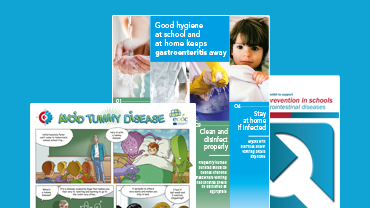Toolkit for investigation and response to Food and Waterborne Disease Outbreaks with an EU dimension
The purpose of this toolkit is to provide investigators with a series of tools that can be useful during an investigation of a European FWD outbreak, i.e. an outbreak that involves at least two EU Member States.
Download
Food- and waterborne disease (FWD) outbreaks in European Member States are important causes of morbidity and economic loss because of their frequent occurrence and also their occasional severity – as exemplified by the German outbreak with STEC O104 that occurred in May 2011.
Well conducted investigations of such outbreaks are important in order to stop the outbreaks and prevent re-occurrence of similar outbreaks. Their investigation may sometimes be challenging and outbreaks affecting several European Member States may be particularly difficult to manage and require a coordinated international approach. The responsibility hereof may lie with the country that is most affected by an outbreak or with the ECDC or another international organisation.
The primary purpose of this toolkit is to provide material that can be helpful when coordinating European FWD outbreak investigations. However, the ECDC also have wished to develop tools that could be of use for investigators at the Member State level.
The Toolkit contains two different types of material:
- Documents, guidelines and explanatory texts that may be needed for international outbreak investigations;
- The other consists of a functionality developed in the software EpiData. Optimal use of these tools requires some degree of familiarisation with the software. The EpiData functionality is still under development, independent of the Toolkit. New features will therefore be available in the coming years.
Please note that although downloading this software is necessary in certain parts of the toolkit, ECDC assumes no liability for any damage or loss arising from its use.
The tools have been arranged in order to fit the "10 steps of an outbreak investigation"-scheme.
10 steps of an outbreak investigation:
1. Confirm outbreak and diagnosis
- More cases than expected? Problem properly diagnosed?
- Multiple countries affected?
- Coordinated investigation needed?
- Decide on coordinator of investigation (Member State, ECDC, EC, WHO etc.);
- Form outbreak control team;
- Alert other networks and entities.
2. Define a case
- Agree on case definitions - confirmed, probable, possible.
3. Identify cases and obtain information
- Conduct case finding by means appropriate to the outbreak;
- Obtain information on disease and exposures.
4. Describe data collected
- Characterize the outbreak by time (epidemic curve), place and person.
5. Develop hypothesis
- Interpret the descriptive findings;
- Use information from trawling interviews or other relevant national studies;
- Review available evidence on previous outbreaks;
- Assess surveillance data and existing knowledge on reservoirs and presence in foods (EFSA, TESSy, EPIS and Zoonoses reports).
6. Test hypothesis: analytical studies
7. Microbiological investigation and additional studies
- Collect food, water and/or environmental samples;
- Determine what happened with the implicated source or vehicle;
- Collect information on food distribution/traceback investigations (origin of foods).
8. Implement control measure (by national and EU authorities)
9. Communicate results, including outbreak report
10. Evaluate and update procedures and toolbox
About this toolkit
Toolbox for investigation and response to Food and Waterborne Disease Outbreaks with an EU dimension" is an ECDC project executed by:
1.Statens Serum Institut, Copenhagen, Denmark & The Norwegian Institute of Public Health, Oslo, Norway – Tool 1, 2, 3, 4, 5b, 6, 7, 8
2.Dutch National Institute for Public Health and the Environment (RIVM), Bilthoven, the Netherlands – Tool 5a
Publication data
Tools for public health
Recommendations for when to consider an internationally coordinated investigation (tool 1)
These recommendations concern outbreaks affecting more than one country
Tools for public health
Checklist for teleconference (tool 2)
The objective of this tool is to develop a checklist of topics that should be addressed at the first teleconference (and possible subsequent teleconferences) between the affected EU member states, the ECDC and possibly other relevant stakeholders at EU level in order to coordinate the investigation
Tools for public health
Case definitions for investigation of international FWD outbreaks (tool 3)
The purpose of this tool is to identify unique components that might need to be included in a case definition relating to an international foodborne outbreak and provide examples of case definitions that could be useful to Member States, the ECDC and any other potential stakeholders.
Tools for public health
Recommendations for case finding (tool 4)
Case finding is among the necessary steps in any national and international FWD outbreak investigations in order to assess the extent of the outbreak, to help identify the source and to implement control measures.
Tools for public health
Outbreak investigation questionnaire - Repository of questions (tool 5a)
Questionnaire investigations are central tools in outbreak investigations. For foodborne outbreaks that affect more than one country, it is important to be able to quickly make questionnaires and collect data in a uniform format that can be shared and readily analysed
Tools for public health
Outbreak investigation questionnaire – Introduction to EpiData (tool 5b)
EpiData is a free software that has been developed for field epidemiology investigations
Tools for public health
Software for data analysis and considerations for when to perform analytical studies (tool 6)
The EpiData Analysis module (EpiDataStat) is a software that enables the user to perform basic descriptive epidemiological analysis based on an interview dataset obtained from an outbreak investigation.
Tools for public health
Considerations for environmental and microbiological studies (tool 7)
This tool contains concerns the use of typing in outbreak investigations. The emphasis here on typing is because the classical microbiological isolation methods, as for instance those used for detection of agents in food samples, are well established and performed according to uniform, standardised protocols.
Tools for public health
Alert systems (tool 8)
This tool provides clarification on the roles and relationships of some the most important international alert systems for European outbreaks of food or waterborne origin.






